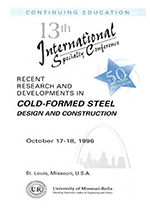Session Dates
17 Oct 1996
Abstract
The results of a series of reversed cyclic 4 ft. x 8 ft. (length x height) 15/32-in. plywood and 7/16-in. oriented strand board (OSB) shear wall tests are presented in this paper. The walls were framed with C-shaped 3-1/2 in. 20 gauge (0.036 in.) studs at 24 in. on center. Each wall was subjected to a sequential phase displacement time history at a frequency of 0.67 Hz. Performance of the wall was shown to depend on the type of sheathing material, the strength of the chord studs, and the screw fastener schedule. Although the hysteretic loops were significantly pinched (a characteristic of the light framed shear wall), the wall was shown to be capable of dissipating significant energy before failure. Based on these limited test data, recommendations for interpretation of these data for design are presented.
Department(s)
Civil, Architectural and Environmental Engineering
Research Center/Lab(s)
Wei-Wen Yu Center for Cold-Formed Steel Structures
Meeting Name
13th International Specialty Conference on Cold-Formed Steel Structures
Publisher
University of Missouri--Rolla
Document Version
Final Version
Rights
© 1996 University of Missouri--Rolla, All rights reserved.
Document Type
Article - Conference proceedings
File Type
text
Language
English
Recommended Citation
Serrette, Reynaud; Hall, Georgi; and Nguyen, Hoang, "Dynamic Performance of Light Gauge Steel Framed Shear Walls" (1996). CCFSS Proceedings of International Specialty Conference on Cold-Formed Steel Structures (1971 - 2018). 1.
https://scholarsmine.mst.edu/isccss/13iccfss/13iccfss-session7/1
Dynamic Performance of Light Gauge Steel Framed Shear Walls
The results of a series of reversed cyclic 4 ft. x 8 ft. (length x height) 15/32-in. plywood and 7/16-in. oriented strand board (OSB) shear wall tests are presented in this paper. The walls were framed with C-shaped 3-1/2 in. 20 gauge (0.036 in.) studs at 24 in. on center. Each wall was subjected to a sequential phase displacement time history at a frequency of 0.67 Hz. Performance of the wall was shown to depend on the type of sheathing material, the strength of the chord studs, and the screw fastener schedule. Although the hysteretic loops were significantly pinched (a characteristic of the light framed shear wall), the wall was shown to be capable of dissipating significant energy before failure. Based on these limited test data, recommendations for interpretation of these data for design are presented.



